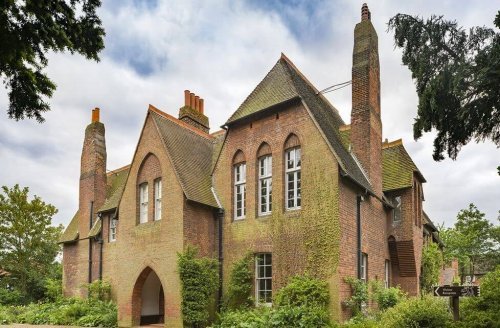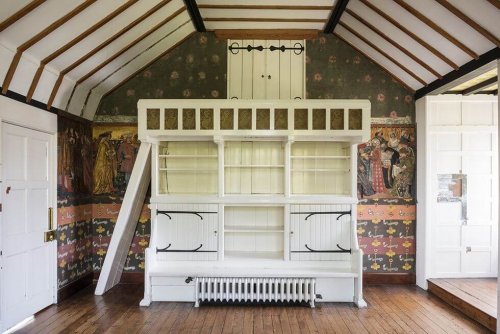The Red House, Where Arts and Crafts Were Born

The Red House, an example of rural artisan work, is a symbol of the Arts and Crafts Movement.
Located in Bexleyheath, the Red House is in Southwest London, England. And this is where the Arts and Crafts Movement began. It was the first architectural work of this movement.
This was a project by Philip Webb in 1859 and was commissioned by William Morris, the artist. In fact, Morris was the principal proponent of this movement. The interior of this home has murals and stained-glass windows by the famous designer, Edward Burne-Jones.
The concept was that the Red House had to be a “palace of arts”. What’s more, it would have to be the place in which he and his friends could create works of art.
Actually, it’s in this house where the idea to create Morris, Marshall, Faulkner, and Co. sprang up, almost as a joke. This was a decor and furniture design business.
The Arts and Crafts Movement
 Exterios/nationaltrustimages.org.uk
Exterios/nationaltrustimages.org.uk
The Arts and Crafts Movement arose as a rejection of the Aesthetic Movement of the Industrial Revolution. To explain, the architecture of the Industrial Revolution was cold and depersonalized. It spread throughout Europe at the beginning of the 20th century. As it turned out, the Industrial Revolution, the Russian Revolution, and the First World War served to dehumanize art.
William Morris and a group of English artists looked at the coldness and dehumanization of the art of the Aesthetic Movement. As a result, these men started to popularize and promote artisan work. This included woven tapestries, rugs with flowers and furniture with wonderful prints.
Years later, this movement would inspire Art Noveau. Also, Liberty fabrics and fine jewelry developed from the movement.
The first time people used the term “Arts and Crafts” was in 1889. It came about thanks to the founding of the Arts and Crafts Exhibition Society. After that, the group organized exhibitions between 1888 and 1916.
This movement evolved and developed into Art Nouveau. In fact, this was a movement that became transatlantic and extended to the United States, where Frank Lloyd Wright became famous.
Don’t have anything in your home that doesn’t have a use and isn’t beautiful.
William Morris
The Red House – the first modern house

This house epitomizes the idea of the Arts and Crafts Movement. Because it’s constructed totally of brick, it is called Red House. As an homage to arts and crafts and a rural refuge, it was the home of William and Janey Morris and their family. Surrounded by gardens and orchards, it was an example of what Morris embodied – transforming the world into beauty.
What stands out in the house is the distribution of interior spaces and the natural light. The Red House is a clear example of the architectural work that responds to the needs of the people living there.
Many architects and historians consider it to be the first modern house in history. The house doesn’t alter the environment. Instead, there is integration between the two elements.
The facade of the house is the result of the distribution of the interior spaces. These were taken into account in the design of the house and the living space could change according to the needs of the family. For example, on the second floor we can see an extension project that never came to fruition.
 Techno/nationaltrustimages.org.uk
Techno/nationaltrustimages.org.uk
The house is constructed of a warm red brick without anything over it. Shingles cover the roof, and other local materials from the area have been used. Like other examples of the Arts and Crafts movement, the Red House doesn’t follow any particular style. You’ll find that the design of the house comes from the thought put into its use.
In the interior of the house, the materials that dominate are wood, tiles, and glass. These are warm and natural materials that make a house cozy. Following the theme, the interior design has an organic inspiration, that’s natural and medieval.
For these reasons, the Red House occupies an important place in the history of architecture and design. In addition, it’s a reflection of an artistic and cultural movement. This movement admired the authenticity and humanity of medieval architecture.
Nevertheless, this house isn’t an ode to the past. On the contrary, it signifies a radical rupture with architecture from the beginning of the previous century. Experts consider it to be a precursor to the architecture of the 20th century because of its unique design.
The Red House, an example of rural artisan work, is a symbol of the Arts and Crafts Movement.
Located in Bexleyheath, the Red House is in Southwest London, England. And this is where the Arts and Crafts Movement began. It was the first architectural work of this movement.
This was a project by Philip Webb in 1859 and was commissioned by William Morris, the artist. In fact, Morris was the principal proponent of this movement. The interior of this home has murals and stained-glass windows by the famous designer, Edward Burne-Jones.
The concept was that the Red House had to be a “palace of arts”. What’s more, it would have to be the place in which he and his friends could create works of art.
Actually, it’s in this house where the idea to create Morris, Marshall, Faulkner, and Co. sprang up, almost as a joke. This was a decor and furniture design business.
The Arts and Crafts Movement
 Exterios/nationaltrustimages.org.uk
Exterios/nationaltrustimages.org.uk
The Arts and Crafts Movement arose as a rejection of the Aesthetic Movement of the Industrial Revolution. To explain, the architecture of the Industrial Revolution was cold and depersonalized. It spread throughout Europe at the beginning of the 20th century. As it turned out, the Industrial Revolution, the Russian Revolution, and the First World War served to dehumanize art.
William Morris and a group of English artists looked at the coldness and dehumanization of the art of the Aesthetic Movement. As a result, these men started to popularize and promote artisan work. This included woven tapestries, rugs with flowers and furniture with wonderful prints.
Years later, this movement would inspire Art Noveau. Also, Liberty fabrics and fine jewelry developed from the movement.
The first time people used the term “Arts and Crafts” was in 1889. It came about thanks to the founding of the Arts and Crafts Exhibition Society. After that, the group organized exhibitions between 1888 and 1916.
This movement evolved and developed into Art Nouveau. In fact, this was a movement that became transatlantic and extended to the United States, where Frank Lloyd Wright became famous.
Don’t have anything in your home that doesn’t have a use and isn’t beautiful.
William Morris
The Red House – the first modern house

This house epitomizes the idea of the Arts and Crafts Movement. Because it’s constructed totally of brick, it is called Red House. As an homage to arts and crafts and a rural refuge, it was the home of William and Janey Morris and their family. Surrounded by gardens and orchards, it was an example of what Morris embodied – transforming the world into beauty.
What stands out in the house is the distribution of interior spaces and the natural light. The Red House is a clear example of the architectural work that responds to the needs of the people living there.
Many architects and historians consider it to be the first modern house in history. The house doesn’t alter the environment. Instead, there is integration between the two elements.
The facade of the house is the result of the distribution of the interior spaces. These were taken into account in the design of the house and the living space could change according to the needs of the family. For example, on the second floor we can see an extension project that never came to fruition.
 Techno/nationaltrustimages.org.uk
Techno/nationaltrustimages.org.uk
The house is constructed of a warm red brick without anything over it. Shingles cover the roof, and other local materials from the area have been used. Like other examples of the Arts and Crafts movement, the Red House doesn’t follow any particular style. You’ll find that the design of the house comes from the thought put into its use.
In the interior of the house, the materials that dominate are wood, tiles, and glass. These are warm and natural materials that make a house cozy. Following the theme, the interior design has an organic inspiration, that’s natural and medieval.
For these reasons, the Red House occupies an important place in the history of architecture and design. In addition, it’s a reflection of an artistic and cultural movement. This movement admired the authenticity and humanity of medieval architecture.
Nevertheless, this house isn’t an ode to the past. On the contrary, it signifies a radical rupture with architecture from the beginning of the previous century. Experts consider it to be a precursor to the architecture of the 20th century because of its unique design.







